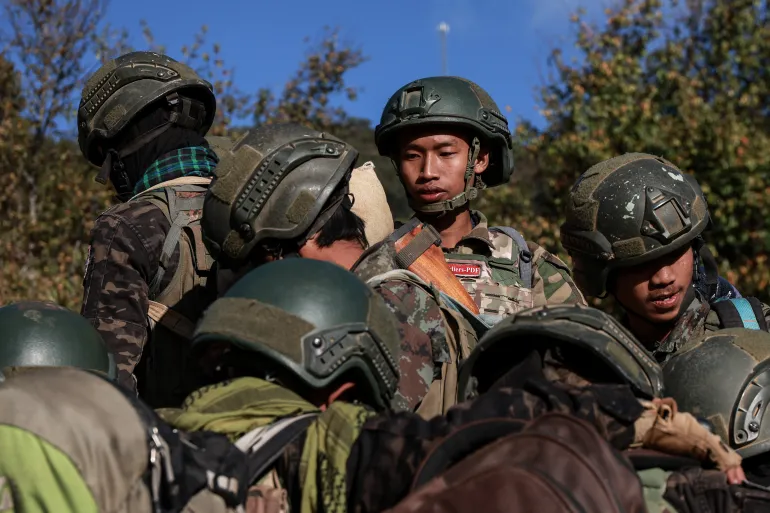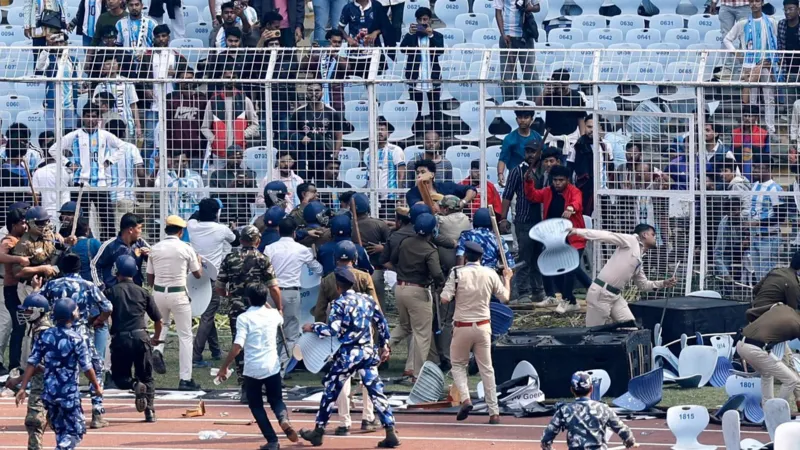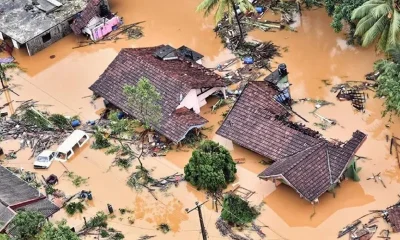Foreign News
‘Inch by inch’: Myanmar rebels close in on key military base in Chin State

In the mountains of western Myanmar, photographs of fallen fighters line a wall of a rebel headquarters – an honour roll of some 80 young men, beginning with 28-year-old Salai Cung Naw Piang, who was killed in May 2021.
The true toll on the Chin National Defence Force (CNDF) extends beyond this hall and grows as war against Myanmar’s military grinds on in Chin State – a Christian region of the country bordering India where ethnic Chin fighters have expelled the military from most of their territory.
“Even if they don’t surrender, we will go till the end, inch by inch,” CNDF Vice President Peter Thang told Al Jazeera in a recent interview.
Launched in mid-November, the Chin offensive to capture the town of Falam – codenamed “Mission Jerusalem” – has come at a heavy cost. About 50 CNDF and allied fighters were killed in the first six weeks, some buried alive after direct air strikes by jet fighters of Myanmar’s military regime on earthen bunkers, Thang said.
Thang estimated similar casualties among Myanmar’s military, and more than 100 government soldiers captured, in the continuing operation.
Formed by civilians to fight the military after the 2021 coup in Myanmar, the CNDF has encircled the regime’s last garrison in a hilltop base in Falam.
“We are facing a difficult time,” Thang admitted.
“If God is willing to hand over the enemy, we will take it,” he said of Mission Jerusalem’s ultimate objective.
Taking and holding Falam – Chin State’s former capital – would also mark the first district centre captured by the country’s new rebel forces without support from established ethnic armies, according to Thang, who ran a travel agency in Myanmar’s commercial capital Yangon before the coup.
“We have more challenges than others,” he said.
“The military has so much technology. We have limited weapons, and even some of them we can’t operate,” he added.
![Peter Thang, Chin National Defence Force (CNDF) vice president, sits in front of the CNDF flag during an interview in a village at the frontline in Falam, Chin State, Myanmar, January 2, 2025. [Valeria Mongelli/Al Jazeera]](https://www.aljazeera.com/wp-content/uploads/2025/03/AB5A6226-1742020482.jpg?w=770&resize=770%2C513&quality=80)
With the CNDF supported by fighters from 15 newly formed armed groups, including from Myanmar’s ethnic Bamar majority, about 600 rebels have besieged Falam and the roughly 120 government soldiers who, confined to their hilltop base, depend on supplies dropped by helicopter for their survival.
Unlike established ethnic armies who are fighting to gain more territory for themselves, the rebel forces massed in Chin State said they aim to overthrow Myanmar’s military regime entirely.
While the CNDF and allies in the Chin Brotherhood (CB) coalition scored previous victories against the military with help from the powerful Arkan Army [AA] to thesouth in Rakhine State, seizing Falam independently would represent a new phase in Myanmar’s revolution.
But the biggest challenge in the battle remains aerial attacks by the military.
Operations against the hilltop base in Falam trigger bombardments from the military’s Russian and Chinese fighter jets, along with rocket-propelled grenades, artillery, sniper and machinegun fire from troops defending the outpost.
![A Chin National Defence Force (CNDF) fighter points to the Myanmar military's base in Falam, Chin State, Myanmar, December 31, 2024. Peter Thang, Chin National Defence Force (CNDF) vice president, sits in front of the CNDF flag during an interview in a village at the frontline in Falam, Chin State, Myanmar, January 2, 2025. [Valeria Mongelli/Al Jazeera]](https://www.aljazeera.com/wp-content/uploads/2025/03/0H1A3676-1742020649.jpg?w=770&resize=770%2C513&quality=80)
CNDF commanders told how the besieged soldiers once chatted freely with locals and some had even married local Chin women. But that all changed when Myanmar’s security forces shot peaceful protesters demonstrating against the military’s ousting of Aung San Suu Kyi’s elected government in 2021.
Demonstrators fought back, and an uprising was born that has become steeped in blood and the lore of many martyrs.
Mya Thwe Thwe Khaing, a 19-year-old protester, was the first victim – shot in the head by police on February 9, 2021 in the country’s capital, Naypyidaw.
In April 2021, armed with hunting rifles, the Chin launched the first significant battle of Myanmar’s uprising in Mindat town, which has since been liberated.
Now the rebels are equipped with assault rifles and grenade launchers. They control most of the countryside and several towns, but remain outgunned, as the military entrenches itself in urban centres. Unable to launch ground offensives from their depleted ranks, the regime’s generals have turned to forced conscription and indiscriminate air strikes nationwide.
According to rights group the Assistance Association for Political Prisoners, the military has killed at least 6,533 civilians since the coup. With at least 3.5 million people displaced inside the country, according to the United Nations, observers predict even fiercer fighting this year.

In Falam, CNDF defence secretary Olivia Thawng Luai said spouses live with some of the soldiers in the surrounded hilltop holdout.
“Most soldiers want to leave their base but they are under the commander’s control,” said Olivia Thawng Luai, a former national karate champion. “They aren’t allowed to leave the base or use their phones,” she said.
Another senior CNDF figure, Timmy Htut, said the commander in the besieged base still has his own phone – and the rebels call his number regularly.
“One day he will pick up,” he said. “When he’s ready.”
Attempts by the military to send reinforcements to Falam have failed. Helicopters, facing sheets of gunfire, have dropped conscripted airborne recruits on Falam’s outskirts, ordering them to fight their way into the town. None has succeeded.
![Olivia Thawng Luai, Chin National Defence Force (CNDF)'s defence secretary, is portrayed in a village at the frontline in Falam, Chin State, Myanmar, January 1, 2025. [Olivia Thawng Luai, Chin National Defence Force (CNDF)'s defence secretary, sits in front of the CNDF flag during an interview in a village at the frontline in Falam, Chin State, Myanmar, January 1, 2025 A Chin National Defence Force (CNDF) fighter stands on the ruins of a church bombed by a Myanmar military jet in Falam township, Chin State, Myanmar, December 31, 2024. [Valeria Mongelli/Al Jazeera]](https://www.aljazeera.com/wp-content/uploads/2025/03/AB5A6023-1742020999.jpg?w=770&resize=770%2C513&quality=80)
A captured soldier said his unit was dropped in without a plan, and, under heavy fire and pursued by resistance fighters, they scattered in chaos.
“Some died, others ran in all directions,” the soldier told Al Jazeera.
“The headquarters said they couldn’t waste their jet sorties for just a few of us,” he said. The military, he continued, has lost “many skilful, valuable” soldiers since the coup.
“They gave their lives for nothing,” he said.
“In the end, the military leaders will offer peace talks, and there will probably be democracy.”
Among the people displaced by fighting in Falam, and who are forced to shelter under bridges and tarpaulins, a new generation prepares to fight.
Junior, 15, who assists at a Chin hospital camp, spoke from an air raid shelter within earshot of jets dropping bombs.
“I’ll do whatever I can,” Junior said. “There’s no way to study in Myanmar. I don’t want future generations to face this,” she said.

But the Chin resistance is also grappling with internal division. It has split into two factions: one led by the Chin National Front (CNF), established in 1988, along with its allies, and the other, the Chin Brotherhood, comprising six post-coup resistance groups, including the CNDF.
Their dispute centres on who shapes Chin’s future – the CNF favouring a dialect-based governance structure, the CB preferring the governing of townships. This distinction between language and land determines the distribution of power, and, coupled with tribal rivalries and traditional mistrust, has led to occasional violent clashes among the Chin groups.
Myanmar analyst R Lakher described the divide as “serious”, though mediation efforts by northeast India’s Mizoram authorities show progress.
On February 26, the two rival factions announced they would merge to form the Chin National Council, with a goal of uniting different armed groups under one military leadership and administration.
While welcoming the development, Lakher stressed the process must be “very systematic” and include key political leaders from either side, not only advocacy groups.
“Chin civilians have suffered most,” he said. “Despite liberation, some cannot return home because of this internal conflict.”
Capturing Falam would be “significant”, he said, as nearby Tedim town would then present an easier target, potentially freeing up more territory for the CB and strengthening their negotiating position with the CNF coalition.
Lakher estimated more than 70 percent of Chin State has been liberated.
“We’ve seen the junta being defeated across Myanmar,” he said. “But pro-democracy forces need unity.”
He said the onus was on the National Unity Government – described as Myanmar’s shadow government – to “bring all democratic forces together”.
“With so many armed groups, there’s concern they’ll fight each other without strong leadership,” he said. “Ethnic areas are being liberated while Bamar lands remain under military control. The revolution’s pace now depends on the Bamar people.”

Along the road leading out of Falam town, two trucks loaded with captured regime soldiers drove past Chin’s bombed churches, gardens of mustard leaf, and mothers cradling babies under heavy shawls. As the trucks crossed paths with resistance fighters heading to the front, the nervous prisoners of war claimed they had been forced into military service.
“You were conscripted five months ago,” a rebel fighter remonstrated with prisoners in the truck. “What were you doing before then? he asked. He then added: “We’ve been fighting the revolution.”
Another rebel joined in the rebuke.
“Count yourselves lucky to be captured here,” he said – and not in the country’s harsh central drylands, where rebel units roam unchecked.
“None of you would be alive there,” he added.
[Aljazeera]
Foreign News
UK and South Korea strike trade deal

The UK and South Korea have finalised a trade deal which the government says will create thousands of jobs and bring billions into the British economy.
British industries including pharmaceuticals, car manufacturing, alcohol and financial services are expected to benefit from an extension to the current tariff-free trade on most goods and services.
The deal is the fourth such agreement struck by the Labour government, following deals with the EU, US and India — none of which have had a material impact on the UK’s economy so far.
South Korean culture, including music, cosmetics and food, has become much more popular in the UK in recent years.
(BBC)
Foreign News
Rob Reiner’s son Nick arrested for murder after director and wife found dead

A son of film director Rob Reiner and Michele Singer Reiner has been arrested and booked on suspicion of murder after the couple were found dead in their Los Angeles home.
The Los Angeles Police Department said on Monday that Nick Reiner, 32, had been arrested and that he was in custody with no bail.
The deceased couple’s 28-year-old daughter, Romy, found her parents in their home with multiple stab wounds on Sunday, sources told the BBC’s US partner CBS News.
Rob Reiner is known for directing several iconic films in a variety of genres, including When Harry Met Sally, This is Spinal Tap, Stand By Me, Misery and A Few Good Men.
Emergency services were called to provide medical aid at the Reiners’ Brentwood, California, home at around 15:38 local time (23:38 GMT) on Sunday.
The Los Angeles Fire Department said two people – later identified as Rob Reiner, 78, and his wife Michele, 68 – were pronounced dead at the scene.
Police said Nick Reiner was arrested several hours later, at about 21:15 local time on Sunday. Investigators have not publicly outlined a motive and said the investigation remains ongoing.
(BBC
Foreign News
Angry fans throw chairs and bottles at Messi event in India

Angry fans attending Lionel Messi’s tour of India ripped up seats and threw items towards the pitch after his appearance at Kolkata’s Salt Lake Stadium.
Thousands of adoring supporters had paid up to 12,000 rupees (£100; $133) to catch a glimpse of the football star, but were left disappointed when he emerged to walk around the pitch and was obscured by a large group of officials and celebrities.
When the Argentina and Inter Miami forward was whisked away early by security after around 20 minutes, elements of the crowd turned hostile.
West Bengal’s chief minister, Mamata Banerjee, said she was “deeply disturbed and shocked” by the events.
Announcing an enquiry, Banerjee apologised to Messi and “sports lovers” for the incident at the stadium.
“The enquiry committee will conduct a detailed enquiry into the incident, fix responsibility, and recommend measures to prevent such occurrences in the future,” the chief minister said on X.
A spokesperson for Messi said that he fulfilled the time commitment that had been agreed in advance. In terms of the organisation of the event itself, he referred the BBC to the apology issued by Banerjee on social media.
A police official told reporters that the event’s “chief organiser” had been arrested, without giving any further details, AFP reports.
Authorities will look into how organisers could refund money to those who bought tickets, the official added.
The All India Football Federation (AIFF) said it was not involved in the “private event”.
Messi is in India for his ‘GOAT [greatest of all time] tour’, a series of promotional events in Kolkata, Hyderabad, Mumbai and Delhi.
His tour began with the unveiling of a 70ft [21m] statue of himself in Kolkata, which had been assembled over the course of 27 days by a 45-strong crew. Messi appeared virtually due to security concerns.
Thousands of fans travelled to the city’s stadium for a chance to see the footballer in person.
They were chanting, buying jerseys and wearing “I love Messi” headbands.
Messi initially walked out at the stadium waving to fans, but after his appearance was abruptly ended on Saturday, some frustrated fans stormed the pitch and vandalised banners and tents, as others hurled plastic chairs and water bottles.
The 2022 World Cup winner – consdered one of football’s greatest ever players – had been expected to play a short exhibition game at the stadium, the AFP news agency reports.
“Only leaders and actors were surrounding Messi… Why did they call us then? We have got a ticket for 12,000 rupees, but we were not even able to see his face,” a fan at the stadium told Indian news agency ANI.
One angry fan told the Press Trust of India news agency people had paid the equivalent of a month’s salary to see the eight-time Ballon d’Or winner.
“I paid Rs 5,000 for the ticket and came with my son to watch Messi, not politicians,” they said.
“The police and military personnel were taking selfies, and the management is to blame.”
Messi was accompanied on his brief visit by his Inter Miami teammate and Uruguay star Luis Suarez, and Argentina’s Rodrigo de Paul.
Bollywood actor Shah Rukh Khan also met Messi earlier in the day, according to the Reuters news agency.


Kolkata is the capital of the Indian state of West Bengal and has a large football fanbase in an otherwise cricket-crazed country.
In the city, it is common to see hundreds of thousands of fans gather at stadiums at a derby of local clubs.
In the early hours of Saturday, thousands lined the roads and congregated outside the hotel where Messi was staying to try and catch a glimpse of him.
Hitesh, a 24-year-old corporate lawyer, flew nearly 1,900 kilometres from the south Indian city of Bengaluru.
“For me it’s personal. You can see I am quite short, and I love to play football with my friends,” Hitesh told the BBC, standing in front of the statue.
“Messi is the player I related with the most, no one can match his talent. He gives me hope that with talent you can do anything.”
[BBC]
-

 Business6 days ago
Business6 days agoCabinet approves establishment of two 50 MW wind power stations in Mullikulum, Mannar region
-

 News6 days ago
News6 days agoGota ordered to give court evidence of life threats
-

 Features6 days ago
Features6 days agoCliff and Hank recreate golden era of ‘The Young Ones’
-

 Features6 days ago
Features6 days agoSri Lanka and Global Climate Emergency: Lessons of Cyclone Ditwah
-

 Latest News7 days ago
Latest News7 days agoSri Lanka squad named for ACC Men’s U19 Asia Cup
-

 Editorial6 days ago
Editorial6 days agoExperience vs. Inexperience
-

 News6 days ago
News6 days agoWFP scales up its emergency response in Sri Lanka
-

 News6 days ago
News6 days agoSpecial programme to clear debris in Biyagama













